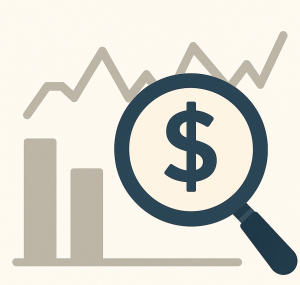Reverse Mortgage Rates
There are 4 rates you need to be aware of when it comes to reverse mortgages…
Yes, four!
This is different to a regular mortgage – 2 of them don’t even exist for regular mortgages and 1 of them is much more important – as I’ll explain below.
You need to be aware of all 4 as it would be very easy for a lender to tempt you in with a low rate upfront but then sneak costs into these other rates.
Here are the 4 rates with a brief description:
- The initial interest rate – this one is simple – what you’ll pay on the initial money you borrow. This is the same as with a regular mortgage. Ironically – despite being the one people focus on – this might be the least important when it comes to a reverse mortgage. This will typically be on a 1 to 5 year term.
- The rate to take a lump sum later. This doesn’t exist for a regular mortgage (since all the money is borrowed upfront) but with a reverse mortgage you don’t need to take all the money available to you upfront. You can come back and take more money later (an excellent way to save on interest) but often these are different.
- The rate to take regular monthly amounts. With a reverse mortgage – unlike a regular mortgage – you can also have regular monthly amounts paid into your bank account (eg. $3,000 a month). The lenders can charge different rates for this too.
- The rate when your initial rate expires. All mortgage rates (with one exception) are for 1-5 years in Canada. When this rate (which is rate #1 above) expires, you’ll be offered a new 1-5 year rate and this is another place lenders could sneak in rate increases if you aren’t careful.
Here are all the rates offered for each type of rate by the 4 current lenders in Canada (as well as one of the lenders who has 2 separate products) – with some explanation of what you need to think about.
Please note: not all lenders serve all areas of Canada and may not be available in your area.

Rate #1 – The Initial Rate You Get On Your Reverse Mortgage
| Bloom – Regular | Bloom – Safe Rate | Equitable | Home Equity Bank (CHIP) | Home Trust |
|---|---|---|---|---|
| 6.59% | 6.69% | 6.54% | 6.64% | 6.54% |
Some things to note about rate 1:
- These are all 5 year fixed rates which are the lowest rates offered by all the lenders – with the exception of the Bloom Safe Rate which is a lifetime rate.
- Some of the lenders will offer slightly lower rates if you’re taking a smaller amount – so enquire about this if that’s the case.
- The counter is also true – lenders will offer slightly higher rates if you’re looking to take really large amounts (generally above 55%).
- 6 months, 1 year and 3 year fixed rates are also offered by the lenders but I would not recommend taking them. They are all higher rates right now and there is no advantage to them at all – you should take the term that has the lowest rate.
- If you take a shorter term, you open yourself up to additional costs earlier at renewal (see rate #4 below) and there is no advantage when it comes to penalties and early repayment since penalties are not dictated by the term for a reverse mortgage (for more on this, see this article: Selecting A Term – The Biggest Mistake You Can Make With A Reverse Mortgage).
- There is a 5 year variable rate available – it’s almost always around Prime +2.6% to +2.7%. That high a premium to Prime is never going to be worth taking. And because penalties are different with a reverse mortgage (penalties on a variable are lower with a regular mortgage but not with a reverse mortgage), there is no other advantage to taking it.

Rate #2 – The Rate If You Want To Take Lump Sum Payments Later
| Bloom – Regular | Bloom – Safe Rate | Equitable | Home Equity Bank (CHIP) | Home Trust |
|---|---|---|---|---|
| At the current market 5 year fixed rate | At the current market 5 year fixed Safe Rate | At the current market 1–3 year rate – varies | At the current posted 1–3 year rate – varies | At the current market 1–3 year rate – varies |
| Currently 6.59% | Currently 6.69% | Currently as high as 6.89% | Currently as high as 7.59% | Currently as high as 6.89% |
Some things to note about rate 2:
- All of these rates will change as interest rates go up and down – they’re all based on whatever the market rates are at the time (except for Home Equity which uses higher posted rates – but these will still move up and down).
- That is to say, if in 10 month’s time you go to take a lump sum, interest rates may have gone up or down in the 10 months. I’ve shown what the current rates are merely to illustrate what the lenders are offering and how they compare to the rest of the market.
- Taking lump sum amounts later (eg. take $100,000 now then $50,000 after a year, then another $50,000 after a year) is a great way to save on interest with a reverse mortgage and one of the biggest differentiators to a regular mortgage. For more on this strategy and a real life example of how it was used to save $45,000, see this article: Better Than A Lower Rate – Get 0% Interest On Part Of Your Reverse Mortgage
- With both Bloom products, you get future funds at their market 5 year fixed rate. Since this is the lowest rate they offer, they’re the only current lender who offers future withdrawals at their lowest rate.

Rate #3 – The Rate If You Want To Take Regular Monthly Payments
| Bloom – Regular | Bloom – Safe Rate | Equitable | Home Equity Bank (CHIP) | Home Trust |
|---|---|---|---|---|
| At the current market 5 year fixed rate | At the current market 5 year fixed Safe Rate | At the 5 year variable rate | At the 5 year variable rate | At the 5 year variable rate |
| Currently – 6.59% | Currently – 6.69% | Currently P+2.60% – 7.05% | Currently P+2.66% – 7.11% | Currently P+2.60% – 7.05% |
Some things to note about rate 3:
- Most of the notes I made about rate 2 above also apply to rate 3.
- Bloom also is the only lender with the option for a debit card – where you can take up to $3,000 per month and only withdraw the cash as and when you spend it.

Rate #4 – Reverse Mortgage Renewal Rates
| Bloom – Regular | Bloom – Safe Rate | Equitable | Home Equity Bank (CHIP) | Home Trust |
|---|---|---|---|---|
| Renewed at current market 5 year fixed rate | N/A – there is no renewal on this rate; it’s a lifetime rate | Renewed at the current market 5 year fixed rate | At the current posted 5 year fixed rate plus a premium | At the current market 5 year fixed rate |
| Have previously seen premiums as high as 0.3% | No premiums since it’s a lifetime rate | Have previously seen premiums as high as 0.3% | Have previously seen premiums as high as 2% | New to the market – so no history of premiums yet |
| Currently – 6.59% (No premiums) |
Currently – 6.69% (No premiums) |
Currently – 6.59% (No premiums) |
Currently – 7.24% to 8.64% (Premium of 0.6% to 2%) |
Currently – 6.59% (No premiums) |
Some things to note about rate 4:
- When I talk about ‘premiums’ I mean an amount that is added on to the current market rate at renewal time. For example, in 5 years time – when your initial rate (rate #1) expires – if the lender you’re with uses a 0.6% premium and the rates have dropped to 6.29%, you’ll be offered 6.89% (6.29% + 0.6% premium).
- Again – these rates are likely to be different in 5 years time, as they’re based on market rates. I’ve shown what the current rates are merely to illustrate what the lenders are offering, the premiums (hidden fees) that they may tack on and how they compare to the rest of the market.
- Premiums and the use of them change over time. At any point in time a lender can decide to add a premium on, get rid of the premium or even use different premiums. That’s why I’ve include information about the history of premiums with each lender, so you can get a feel for what their policies have been and how high premiums have been in the past.
- Knowing the renewal rate options is more important with a reverse mortgage than a regular mortgage for three reasons: (1) there are fewer lender options available – so you can’t just take your mortgage to one of dozens of lenders who have better rates, as there only are 4 lenders, (2) penalties may apply to break a reverse mortgage at the end of your term – which isn’t the case with a regular mortgage – so you have this additional cost to move lenders and (3) if your balance has grown enough, you may not qualify for enough money to pay it off with a new lender (particularly if you took the maximum funds available to you) – so you might be ‘stuck’ with the lender and unable to move it anyway.

Confused About Reverse Mortgage Rates?
I can understand that all of the above information is quite a lot to take in and very confusing.
If you have any questions, feel free to leave them in the comments below.
You can also request a free reverse mortgage assessment where I’ll take a look at your situation and recommend the best lender – walking you through all these rates (as well as any other hidden costs and fees) to make sure you’re getting the best deal for your situation:
Get Your Free Reverse Mortgage Assessment

A Canadian Chartered Accountant and licensed Mortgage Professional – creator of Reverse Mortgage Pros – the #1 reverse mortgage specialists in Canada. I make it my mission to educate Canadians about how reverse mortgages work so that you can make an informed and educated decision that’s right for you and your family.



